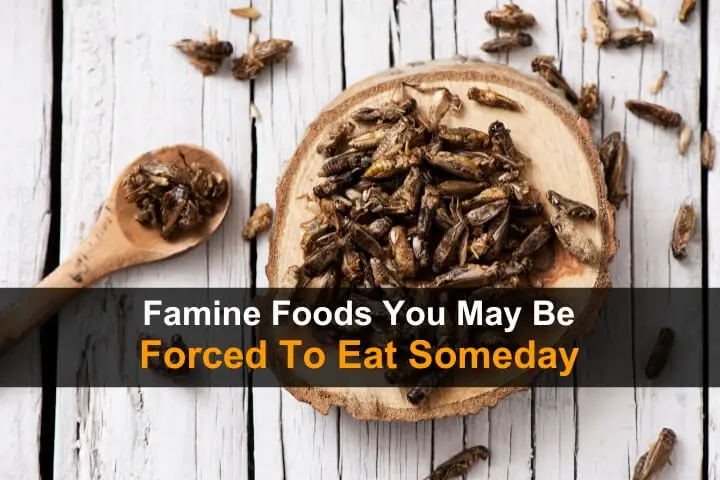Estimated reading time: 8 minutes

When it comes to water and food, there is a saying among preppers, “Stack it to the rafters!” It means to store as much food and water as you possibly can because those are two of the most important resources to have. No matter how much food is stored, raised, or grown, though, even the most well-to-do preppers can find themselves in the middle of a famine.
This is because no plan survives in its entirety and sometimes the stars align and the perfect storm happens. Stored food can go bad or be destroyed or it could be stolen. Livestock and food that is grown, could experience a very bad year like drought or disease, and may not be available.
Does this mean it’s the endgame for you if your food supply goes downhill in a big way? No, but it does mean tough times are on their way and we can learn how to get through famines by looking at history and seeing what others ate during times of hunger.
Nowadays, most of us are so used to only getting our food from a grocery store that it can be easy to forget that there are sources of food all around us, literally. Some of these food options can be quite nutritious but taboo to consume while other options may not offer anything more than simply putting something in your belly.
Want to save this post for later? Click Here to Pin It On Pinterest!
Famine Foods
You might find foods in the following section that have become common items to eat now, but that wasn’t always the case. Also, fair warning, there may be some food options discussed that you may find disturbing or taboo.
Lastly, please keep in mind that some items eaten during a famine may come with consequences or could be harmful. Be sure to do your own in-depth research on specific items before you even consider consuming them. Now that that’s all out of the way, let’s check out some of the foods people have turned to in times of famine.
Tree Bark
Many cultures would eat the inner bark of trees during lean times. The bark could be chewed, then sucked on to remove nutrients, and the “pulp” was spat out or it could be swallowed. Another method was to turn the inner bark into flour and use that for cooking purposes or to fry the bark up much like crispy bacon.
To see how to harvest tree bark, check out the following video.
Insects
Eating insects is still looked down upon by a good portion of the world, while in some regions they are considered a delicacy. Insects are one of the most abundant creatures on the planet so it might be a good time to get over any fears you have of creepy crawlers. A short list of common edible insects includes but are not limited to
- Crickets
- Some types of spiders
- Termites
- Mealworms
- Dragonflies
- Beetles
- Silkworms
- Waterbugs
- Centipedes
- Cicadas
- Stink bugs
- Ants
- Scorpions
- And although they are not insects, worms.
To learn more about and to see how common eating insects is, check out the following video.
If you would like to try eating insects without the hassle of catching and preparing them, you can try a variety of them by getting an affordable bag of mixed insects by clicking here.
Ugali
The following example is from WorldHelp.Net
“Mothers will boil water and mix in cornstarch to form an edible paste called ugali or a thick porridge made from maize meal. In Zimbabwe, children eat amajodo, a tasteless melon that is usually fed to livestock such as donkeys.”
Mud or Dirt Cookies
In Haiti, it is common practice to make dirt cookies, or mud cookies, to feed people when there is nothing else to put in their bellies.
To learn more about dirt cookies, check out the following video.
Pets
To many people the perspective of eating a pet such as a cat or dog is unimaginable, yet this has been done many times throughout history during famines. In fact in some regions of the world today, it is still acceptable for cat or dog meat to be sold or served in a meal.
To see how dog meat is prepared and cooked in some regions, check out the following video.
Insect Flour
If you can’t handle eating raw or cooked insects there is another option. Some insects can be dried and ground into a high-protein powder to make flour. One popular example is cricket flour.
To see how to make cricket flour, check out the following video.
Or if you would like to try out cricket flour without all the catching, drying, and grinding, click here.
Wild Edibles
Like tree bark, people readily turn to wild edibles in times of famine. This is because wild edibles are usually abundant and relatively easy to harvest. There are far too many wild edibles throughout the world to list them all, but here are a few common ones.
- Dandelions,
- Cattails
- Mushrooms
- Berries
- Tubers
- Seaweed
- Kelp
- Moss
- Certain types of tree leaves, pine needles, grasses, and flowers
For more information on wild edibles, check out the following video.
Or get yourself a book on foraging for wild edibles by clicking here.
Non-Livestock Animals
People will normally eat livestock such as cows, pigs, and chickens, but they normally don’t eat non-livestock animals such as horses, donkeys, mules, or oxen. However, during a famine, people have and do eat these types of animals.
To see how horse meat is still prepared, cooked, and consumed today in some countries, check out the following video.
Leather
There have been accounts of people eating leather, such as the kind you find in belts and shoes, during times of extreme famine. Leather would be boiled or held over a heat source to soften it enough to be chewed and digested. It should be noted that leather may contain chemicals from processing that could be quite harmful.
To learn more about how a famous individual from history survived by eating leather, check out the following video.
Cannibalism
As horrific as it may sound, cannibalism has occurred throughout history. I’m not talking about murder. Rather, I’m talking about the many times throughout history where people ate friends or family members who passed away.
Examples include the famous Donner Party in the 1840s or The Great Chinese Famine which happened in the mid-twentieth century and took an estimated 30 million lives.
As taboo as it may be for most people, it’s actually very practical. If the person is dead anyway, why not make use of the meat in their body rather than bury it and feed it to the worms? Of course, this is illegal in most places and should only be done in extreme end-of-the-world type scenarios.
To learn a little bit more and a brief history of cannibalism, check out the this video.
Vermin
There probably hasn’t been a famine yet where vermin didn’t become the target of starving people. Vermin such as mice, and rats which may become abundant at the beginning of a famine, have been eaten in rural and urban environments alike.
To see how mice or rats are prepared, cooked, and eaten, check out the following video.
If you want to be prepared to easily catch mice or rats during tough times, be sure to pick up some mouse traps and rat traps.
Bone Marrow
Bone marrow is an incredibly rich and nutritious substance found only on the inside of formed animal bones. During a famine, nothing goes to waste, and bones are often cooked to break them open so that the marrow can be retrieved, and eaten. Speaking of nothing going to waste…
To see how to prepare a bone so that you can eat the marrow, check out the following video.
Animal Parts
As stated above, nothing goes to waste in times of a famine. Animal parts that may not normally be eaten will be consumed when there is nothing else to eat. Parts such as eyeballs, ears, tongues, noses, brains, feet, tails, and even genitalia.
To see how different parts of an animal are consumed, check out the following video.
Conclusion
In the article above, you may not have seen examples of insects or wild edibles, or other types of famine foods that can be found in your region. This doesn’t mean they don’t exist, it simply means we didn’t have the space to list all of the options under a specific category.
Before a famine strikes, there are two things you can do to be better prepared. One, have a food plan that includes stockpiling food as well as growing it and raising it. And two, learn about the “famine” foods in your region such as wild edibles and insects, so that you will be ready to go when times get tough.
Yes, people can live quite a bit longer than they think they can without consuming any food, 30-40 days give or take the circumstances but it’s not a pretty sight. Our bodies literally consume themselves and we have to watch the same thing happen to those we love.
When famine happens it can make you feel helpless, thinking there is nothing you can do. But history has shown us that people can and have survived by desperately seeking out food sources from anywhere they could.
Like this post? Don’t Forget to Pin It On Pinterest!
You May Also Like:
Read the full article here




